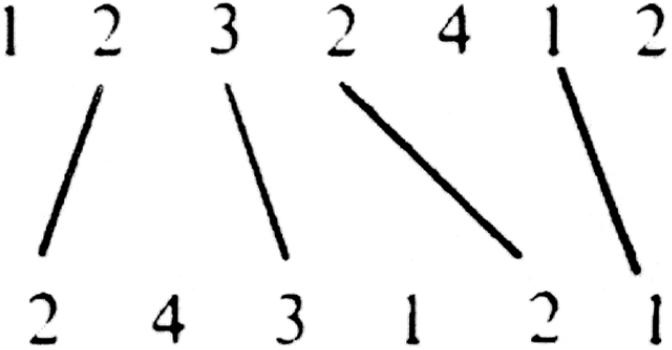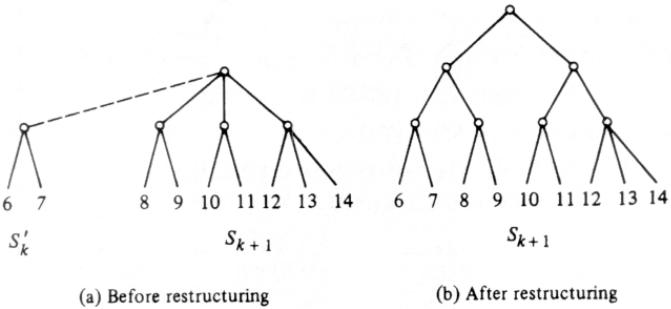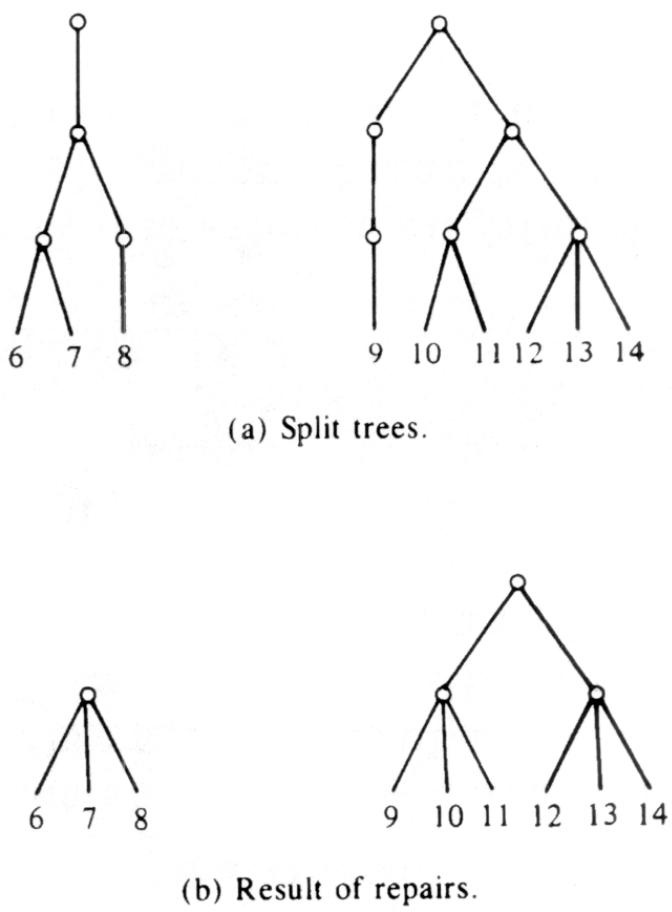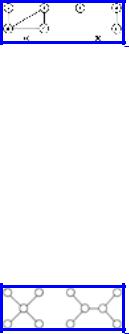
Data-Structures-And-Algorithms-Alfred-V-Aho
.pdf
http://www.ourstillwaters.org/stillwaters/csteaching/DataStructuresAndAlgorithms/images/f5_28.gif
http://www.ourstillwaters.org/stillwaters/csteaching/DataStructuresAndAlgorithms/images/f5_28.gif [1.7.2001 19:14:31]

http://www.ourstillwaters.org/stillwaters/csteaching/DataStructuresAndAlgorithms/images/f5_30.gif
http://www.ourstillwaters.org/stillwaters/csteaching/DataStructuresAndAlgorithms/images/f5_30.gif [1.7.2001 19:14:44]

http://www.ourstillwaters.org/stillwaters/csteaching/DataStructuresAndAlgorithms/images/f5_31.gif
http://www.ourstillwaters.org/stillwaters/csteaching/DataStructuresAndAlgorithms/images/f5_31.gif [1.7.2001 19:15:09]

Data Structures and Algorithms: CHAPTER 7: Undirected Graphs
Undirected Graphs
An undirected graph G = (V, E) consists of a finite set of vertices V and a set of edges E. It differs from a directed graph in that each edge in E is an unordered pair of vertices.† If (v, w) is an undirected edge, then (v, w) = (w, v). Hereafter we refer to an undirected graph as simply a graph.
Graphs are used in many different disciplines to model a symmetric relationship between objects. The objects are represented by the vertices of the graph and two objects are connected by an edge if the objects are related. In this chapter we present several data structures that can be used to represent graphs. We then present algorithms for three typical problems involving undirected graphs: constructing minimal spanning trees, biconnected components, and maximal matchings.
7.1 Definitions
Much of the terminology for directed graphs is also applicable to undirected graphs. For example, vertices v and w are adjacent if (v, w) is an edge [or, equivalently, if (w, v) is an edge]. We say the edge (v, w) is incident upon vertices v and w.
A path is a sequence of vertices v1, v2, . . . , vn such that (vi, vi+1) is an edge for 1 ≤ i < n. A path is simple if all vertices on the path are distinct, with the exception that v1 and vn may be the same. The length of the path is n-1, the number of edges along the path. We say the path v1, v2, . . . , vn connects v1 and vn. A graph is connected if every pair of its vertices is connected.
Let G = (V, E) be a graph with vertex set V and edge set E. A subgraph of G is a graph G' = (V', E') where
1.V' is a subset of V.
2.E' consists of edges (v, w) in E such that both v and w are in V'.
If E' consists of all edges (v, w) in E, such that both v and w are in V', then G' is called an induced subgraph of G.
Example 7.1. In Fig. 7.1(a) we see a graph G = (V, E) with V = {a, b, c, d} and E = {(a, b), (a, d), (b, c), (b, d), (c, d)}. In Fig. 7.1(b) we see one of its induced subgraphs, the one defined by the set of vertices {a, b, c} and all the edges in Fig. 7.1(a) that are not incident upon vertex d.
http://www.ourstillwaters.org/stillwaters/csteaching/DataStructuresAndAlgorithms/mf1207.htm (1 of 22) [1.7.2001 19:15:36]

Data Structures and Algorithms: CHAPTER 7: Undirected Graphs
Fig. 7.1. A graph and one of its subgraphs.
A connected component of a graph G is a maximal connected induced subgraph, that is, a connected induced subgraph that is not itself a proper subgraph of any other connected subgraph of G.
Example 7.2 Figure 7.1 is a connected graph. It has only one connected component, namely itself. Figure 7.2 is a graph with two connected components.
Fig. 7.2. An unconnected graph.
A (simple) cycle in a graph is a (simple) path of length three or more that connects a vertex to itself. We do not consider paths of the form v (path of length 0), v, v (path of length 1), or v, w, v (path of length 2) to be cycles. A graph is cyclic if it contains at least one cycle. A connected, acyclic graph is sometimes called a free tree. Figure 7.2 shows a graph consisting of two connected components where each connected component is a free tree. A free tree can be made into an ordinary tree if we pick any vertex we wish as the root and orient each edge from the root.
Free trees have two important properties, which we shall use in the next section.
1.Every free tree with n ³ 1 vertices contains exactly n-1 edges.
2.If we add any edge to a free tree, we get a cycle.
We can prove (1) by induction on n, or what is equivalent, by an argument concerning the "smallest counterexample." Suppose G = (V, E) is a counterexample to (1) with the fewest vertices, say n vertices. Now n cannot be 1, because the only free tree on one vertex has zero edges, and (1) is satisfied. Therefore, n must be greater than 1.
We now claim that in the free tree there must be some vertex with exactly one incident edge. In proof, no vertex can have zero incident edges, or G would not be connected. Suppose every vertex has at least two edges incident. Then, start at some vertex v1, and follow any edge from v1. At each step, leave a vertex by a different edge from the one used to enter it, thereby forming a path v1, v2, v3, . . ..
http://www.ourstillwaters.org/stillwaters/csteaching/DataStructuresAndAlgorithms/mf1207.htm (2 of 22) [1.7.2001 19:15:36]

Data Structures and Algorithms: CHAPTER 7: Undirected Graphs
Since there are only a finite number of vertices in V, all vertices on this path cannot be distinct; eventually, we find vi = vj for some i < j. We cannot have i = j-1 because there are no loops from a vertex to itself, and we cannot have i = j-2 or else we entered and left vertex vi+1 on the same edge. Thus, i ≤ j-3, and we have a cycle vi, vi+1, . . . , vj = vi. Thus, we have contradicted the hypothesis that G had no vertex with only one edge incident, and therefore conclude that such a vertex v with edge (v, w) exists.
Now consider the graph G' formed by deleting vertex v and edge (v, w) from G. G' cannot contradict (1), because if it did, it would be a smaller counterexample than G. Therefore, G' has n-1 vertices and n-2 edges. But G has one more edge and one more vertex than G', so G has n-1 edges, proving that G does indeed satisfy (1). Since there is no smallest counterexample to (1), we conclude there can be no counterexample at all, so (1) is true.
Now we can easily prove statement (2), that adding an edge to a free tree forms a cycle. If not, the result of adding the edge to a free tree of n vertices would be a graph with n vertices and n edges. This graph would still be connected, and we supposed that adding the edge left the graph acyclic. Thus we would have a free tree whose vertex and edge count did not satisfy condition (1).
Methods of Representation
The methods of representing directed graphs can be used to represent undirected graphs. One simply represents an undirected edge between v and w by two directed edges, one from v to w and the other from w to v.
Example 7.3. The adjacency matrix and adjacency list representations for the graph of Fig. 7.1(a) are shown in Fig. 7.3.
Clearly, the adjacency matrix for a graph is symmetric. In the adjacency list representation if (i, j) is an edge, then vertex j is on the list for vertex i and vertex i is on the list for vertex j.
Fig. 7.3. Representations.
http://www.ourstillwaters.org/stillwaters/csteaching/DataStructuresAndAlgorithms/mf1207.htm (3 of 22) [1.7.2001 19:15:36]

Data Structures and Algorithms: CHAPTER 7: Undirected Graphs
7.2 Minimum-Cost Spanning Trees
Suppose G = (V, E) is a connected graph in which each edge (u, v) in E has a cost c(u, v) attached to it. A spanning tree for G is a free tree that connects all the vertices in V. The cost of a spanning tree is the sum of the costs of the edges in the tree. In this section we shall show how to find a minimum-cost spanning tree for G.
Example 7.4. Figure 7.4 shows a weighted graph and its minimum-cost spanning tree.
A typical application for minimum-cost spanning trees occurs in the design of communications networks. The vertices of a graph represent cities and the edges possible communications links between the cities. The cost associated with an edge represents the cost of selecting that link for the network. A minimum-cost spanning tree represents a communications network that connects all the cities at minimal cost.
Fig. 7.4. A graph and spanning tree.
The MST Property
There are several different ways to construct a minimum-cost spanning tree. Many of these methods use the following property of minimum-cost spanning trees, which we call the MST property. Let G = (V, E) be a connected graph with a cost function defined on the edges. Let U be some proper subset of the set of vertices V. If (u, v) is an edge of lowest cost such that u U and v V-U, then there is a minimum-cost spanning tree that includes (u, v) as an edge.
The proof that every minimum-cost spanning tree satisfies the MST property is not hard. Suppose to the contrary that there is no minimum-cost spanning tree for G that includes (u, v). Let T be any minimum-cost spanning tree for G. Adding (u, v) to T must introduce a cycle, since T is a free tree and therefore satisfies property (2) for free trees. This cycle involves edge (u, v). Thus, there must be another edge (u', v') in T such that u' U and v' V-U, as illustrated in Fig. 7.5. If not, there would be no way for the cycle to get from u to v without following the edge (u, v) a second time.
Deleting the edge (u', v') breaks the cycle and yields a spanning tree T' whose
http://www.ourstillwaters.org/stillwaters/csteaching/DataStructuresAndAlgorithms/mf1207.htm (4 of 22) [1.7.2001 19:15:36]

Data Structures and Algorithms: CHAPTER 7: Undirected Graphs
cost is certainly no higher than the cost of T since by assumption c(u, v) £ c(u', v'). Thus, T' contradicts our assumption that there is no minimum-cost spanning tree that includes (u, v).
Prim's Algorithm
There are two popular techniques that exploit the MST property to construct a minimum-cost spanning tree from a weighted graph G = (V, E). One such method is known as Prim's algorithm. Suppose V = {1, 2, . . . , n}. Prim's algorithm begins with a set U initialized to {1}. It then "grows" a spanning tree, one edge at a time. At each step, it finds a shortest edge (u, v) that connects U and V-U and then adds v, the vertex in V-U, to U. It repeats this
Fig. 7.5. Resulting cycle.
step until U = V. The algorithm is summarized in Fig. 7.6 and the sequence of edges added to T for the graph of Fig. 7.4(a) is shown in Fig. 7.7.
procedure Prim ( G: graph; var T: set of edges );
{ Prim constructs a minimum-cost spanning tree T for G } var
U: set of vertices; u, v: vertex;
begin
T:= Ø;
U := {1};
while U ¹ V do begin
let (u, v) be a lowest cost edge such that u is in U and v is in V-U;
T := T È {(u, v)}; U := U È {v}
end
end; { Prim }
Fig. 7.6. Sketch of Prim's algorithm.
http://www.ourstillwaters.org/stillwaters/csteaching/DataStructuresAndAlgorithms/mf1207.htm (5 of 22) [1.7.2001 19:15:36]

Data Structures and Algorithms: CHAPTER 7: Undirected Graphs
One simple way to find the lowest-cost edge between U and V-U at each step is to maintain two arrays. One array CLOSEST[i] gives the vertex in U that is currently closest to vertex i in V-U. The other array LOWCOST[i] gives the cost of the edge (i,
CLOSEST[i]).
At each step we can scan LOWCOST to find the vertex, say k, in V-U that is closest to U. We print the edge (k, CLOSEST[k]). We then update the LOWCOST and CLOSEST arrays, taking into account the fact that k has been
Fig. 7.7. Seqeunces of edges added by Prim's algorithm.
added to U. A Pascal version of this algorithm is given in Fig. 7.8. We assume C is an n x n array such that C[i, j] is the cost of edge (i, j). If edge (i, j) does not exist, we assume C[i, j] is some appropriate large value.
Whenever we find another vertex k for the spanning tree, we make LOWCOST[k] be infinity, a very large value, so this vertex will no longer be considered in subsequent passes for inclusion in U. The value infinity is greater than the cost of any edge or the cost associated with a missing edge.
The time complexity of Prim's algorithm is O(n2), since we make n-1 iterations of the loop of lines (4)-(16) and each iteration of the loop takes O(n) time, due to the inner loops of lines (7)-(10) and (13)-(16). As n gets large the performance of this algorithm may become unsatisfactory. We now give another algorithm due to Kruskal for finding minimum-cost spanning trees whose performance is at most O(eloge), where e is the number of edges in the given graph. If e is much less than n2, Kruskal's algorithm is superior, although if e is about n2, we would prefer Prim's algorithm.
procedure Prim ( C: array[l..n, 1..n] of real );
{ Prim prints the edges of a minimum-cost spanning tree for a graph with vertices {1, 2, . . . , n} and cost matrix C on edges }
var
LOWCOST: array[1..n] of real; CLOSEST: array[1..n] of integer; i, j, k, min; integer;
http://www.ourstillwaters.org/stillwaters/csteaching/DataStructuresAndAlgorithms/mf1207.htm (6 of 22) [1.7.2001 19:15:36]
Data Structures and Algorithms: CHAPTER 7: Undirected Graphs
{i and j are indices. During a scan of the LOWCOST array, k is the index of the closest vertex found so far, and
min = LOWCOST[k] }
begin
(1)for i := 2 to n do begin
{initialize with only vertex 1 in the set U }
(2) |
LOWCOST[i] := C[1, i]; |
(3) |
CLOSEST[i] := 1 |
|
end; |
(4)for i := 2 to n do begin
{find the closest vertex k outside of U to some vertex in U }
(5) |
min := LOWCOST[2]; |
(6) |
k := 2; |
(7) |
for j := 3 to n do |
(8) |
if LOWCOST[j] < min then begin |
(9) |
min := LOWCOST[j]; |
(10) |
k := j |
|
end; |
(11) |
writeln(k, CLOSEST[k]); { print edge } |
(12) |
LOWCOST[k] := infinity; { k is added to U } |
(13) |
for j := 2 to n do { adjust costs to U } |
(14) |
if (C[k, j] < LOWCOST[j]) and |
|
(LOWCOST[j] < infinity) then begin |
(15) |
LOWCOST[j] := C[k, j]; |
(16) |
CLOSEST[j] := k |
|
end |
|
end |
|
end; { Prim } |
Fig. 7.8. Prim's algorithm.
Kruskal's Algorithm
Suppose again we are given a connected graph G = (V, E), with V = {1, 2, . . . , n} and a cost function c defined on the edges of E. Another way to construct a minimum-cost spanning tree for G is to start with a graph T = (V, Ø) consisting only of the n vertices of G and having no edges. Each vertex is therefore in a connected component by itself. As the algorithm proceeds, we shall always have a collection of connected components, and for each component we shall have selected edges that form a spanning tree.
http://www.ourstillwaters.org/stillwaters/csteaching/DataStructuresAndAlgorithms/mf1207.htm (7 of 22) [1.7.2001 19:15:36]
